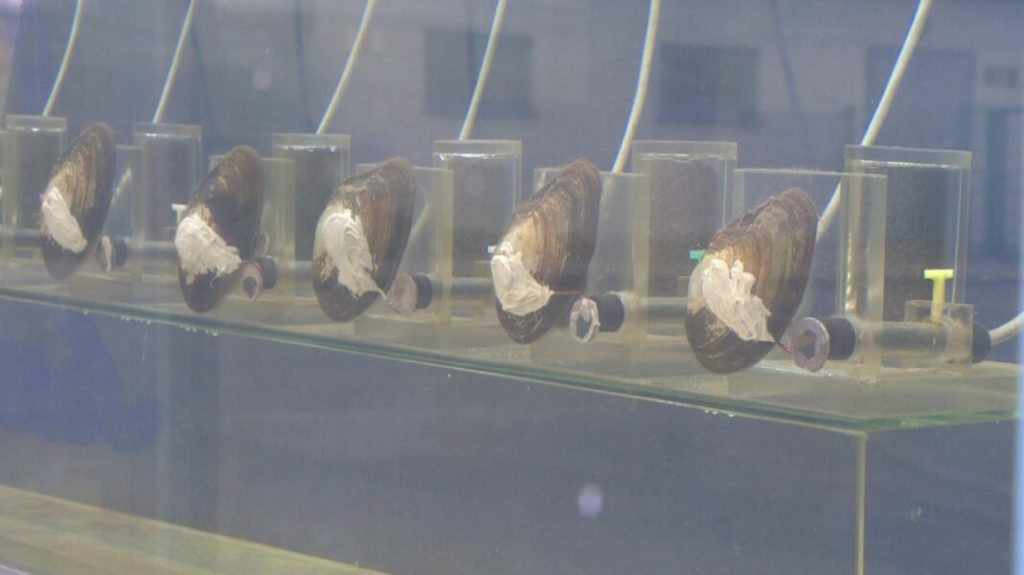Water Safety That Uses Your Mussels
With just over half a million people, the Polish city of Poznań is the fifth largest in the nation. Situated on the Warta River, Poznań dates back more than a century, originally built as a fortress to guard access to the waterway. Today, the Warta is still an important part of Poznań and the surrounding areas; it is a major source of drinking water for the nearly 1.5 million people in Poznań’s greater metropolitan area.
Which is why these guys are so important.

Yes, those are mussels. And they keep the people of Poznań safe.
For decades, the Warta was both a source of drinking water and a great place for industrial sites to dump their waste. And that’s a bad combination. As a result, the river became rather polluted. (If you look at the scientific literature over the past thirty years or so, you’ll find a lot of articles about the pollution levels in the river; here are twoexamples.) The most concerning pollutant is heavy metals — lead, cadmium, chromium, etc. If humans ingest too much of those, we’re susceptible to a condition called heavy metal toxicity, which can be difficult to detect and treat. And when metals are in the water supply, entire populations can suffer, with children being specifically vulnerable to many metals. In short, you don’t want heavy metals in your drinking water.
But running tests for metal contamination can be tricky. Different metals appear on different tests, and you have to know what you’re looking for in order to catch the culprit. Or, at least us humans do. Clams, mussels, and other mollusks don’t have access to hefty scientific equipment or the like, but they, too, need to worry about pollutants (at least to the extent that a mollusk can worry about anything). As the Australian Water Association explains, “with a low tolerance for pollutants, mussels are well known for clamping their shells shut when water quality is poor. [ . . .] If the water is clean, the mussels stay open; if the water becomes polluted, they close.” It’s a crude indicator, but it works, at least for the mussels.
And for the people of Poznań, this same trick is an early warning system. As Smart Water Magazine explains, “The Dębiec Water Treatment Plant relies on the sensitivity of mussels – eight of them – to alert them of water quality problems. Sensors glued on to the mussel shells tell a computer when the shells close. When four mussels close at the same time, the system shuts down.” Each of the mussels, per Polish News, can provide about two months of service; in total, the system requires about 200 mussels per year.
The system isn’t perfect, as the Economist notes: “Clams, as the proverb reminds us, cannot talk. So they never reveal which toxin is causing them to clam up. Also, it seems that they may be less good at detecting dangerous pharmaceuticals.” But it’s good enough to let you know if something is suddenly wrong. And given that it’s powered by creatures picked up in nearby rivers, it’s pretty cheap, too. The water plant has been using the system for more than 25 years, and dozens of other water authorities have adopted similar measures since.
Bonus fact: Sea otters like to eat mussels, clams, and other mollusks, but that can be tricky — if the clams are shut, it’s hard to get the edible parts out. Humans use tools to solve for that and, it turns out, so do sea otters. As CNN explains, “sea otters have been known to crack open shells on their chests using rocks as they float on their backs, but they’ve also been observed using rocks along the shoreline as ‘anvils’ to crack open mussels, clams, and crabs.” And there’s more. According to the Oregon Coast Aquarium, “sea otters have flaps of loose skin under each forearm that they use like a pocket or pouch to carry as much food as possible back to the surface,” and that pocket can double as a toolbox; “many otters have a favorite rock that they store in one of their underarm pockets, carrying it with them wherever they go.”
From the Archives: Anti-Terror Fish: Like the mussels, only fish, and focused on terrorism.
